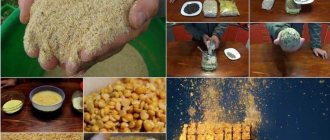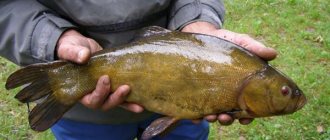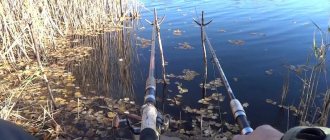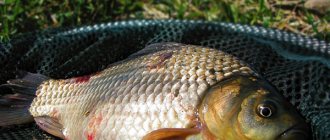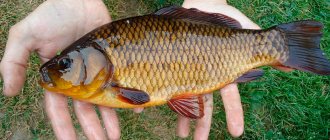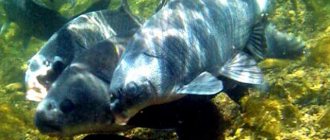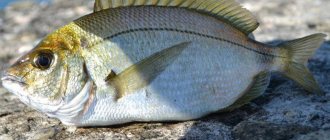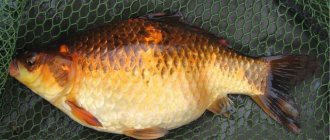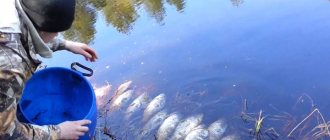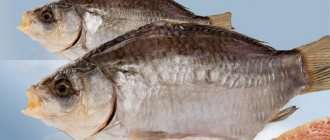Probably every fisherman has caught crucian carp at least once in his life. I got up early and went to a pond or lake to catch this fish. But we go to the pond not only for fish!
Watching the beautiful sunrise, watching the awakening of nature, enjoying the pleasant morning coolness, and from time to time pulling out crucian carp - this is called fishing happiness!
This article is about what weather it is worth catching crucian carp, where exactly to look for it, what kind of bait attracts crucian carp the most, what kind of bait the crucian carp bites best on, and much more.
Crucian biting time
In hot summer weather, crucian carp bites are very rare or non-existent. On a hot day, crucian carp moves away from the shore into holes - the water in them is cooler and there is more oxygen there.
Even very tasty and aromatic baits do not always arouse the appetite of crucian carp at such a time! In the evening, when the heat subsides, crucian carp eventually, flock after flock, emerge from the cool pits to the vegetation and begin to feed. You can successfully catch crucian carp in the evening from about six o'clock.
Crucian carp first of all approaches those places where there is shade from trees - there the water is cooler and there is more oxygen, unlike water warmed up in the sun. When the sun completely sets, crucian carp can be caught along the entire perimeter of the reservoir, and crucian carp continues to actively bite until about 23, after which the bite begins to decline.
At night, catching crucian carp is boring, so it takes the bait very rarely and reluctantly. We advise you to wait until dawn and be at the reservoir at about five o'clock in the morning. Fishing in the morning, as well as in the evening, will delight you with a good catch! In the morning, crucian carp actively bite until about ten o'clock, but the behavior of crucian carp mainly depends on the weather.
Useful article: what does crucian carp eat?
The best weather for catching crucian carp in summer
As noted above, catching crucian carp in the heat is a very hopeless endeavor. But if it's cloudy outside, everything changes. The hot sun is covered by large gray clouds, from which it rains periodically, but at the same time it is quite warm and there is no strong wind - this is exactly the weather that crucian carp like, and it begins to catch well not only near the shore, but also in the depths.
On the contrary, rapid cooling in summer frightens the crucian carp, and it stops feeding for a while. Crucian carp, like many other fish species, does not like sudden changes in pressure. In summer, you should look for crucian carp in or near coastal algae. You should try throwing bait into the windows of algae - in summer these places are the best for crucian carp, and there is also a chance to catch a trophy crucian carp.
About crucian bait
You can remember our childhood years, when we went fishing for crucian carp to the nearest body of water. Back then there was no talk of bait! The main thing that needed to be taken was a jar of dung worms. And even without using any special baits, quite a lot of crucian carp could be caught.
Whether it is worth using bait or not, the fisherman must decide for himself. But we still advise you to use fertilizing, as catching crucian carp becomes more effective and interesting. On our website you can read articles about preparing crucian carp bait; the articles contain several effective and inexpensive recipes.
If in the period from April to May the crucian carp after winter preferred animal baits in the form of a worm, bloodworms, insect larvae, then in the summer it is more interested in plant delicacies (cereals, corn, peas, etc.).
But when the summer heat begins to subside again, you should try to catch it with higher-calorie food. Taking into account the weather, it is worth adding either plant or animal ingredients to the bait. The above can also be applied to attachments.
Sometimes it can be very difficult to choose the right bait to catch crucian carp, and this is especially difficult in the summer.
To find the right bait, you need to experiment - if you don’t bite on one, you should try something else. Therefore, you need to take different baits when fishing. In addition to worms, maggots and bloodworms, it is worth taking pearl barley, bread, dough and corn. Even if you don't use them, they won't go to waste.
You can throw all these goodies into a pond - which will be a good bait for fishing. It also happens that even a foam ball can provoke a crucian carp to bite! Crucian carp bite very well on flies, especially when fishing in the upper layers of water.
Tackle and fishing methods.
Equipment for catching crucian carp should be light and invisible, especially in places regularly visited by fishermen. The crucian carp there is very shy, and if he begins to suspect something, he may swim away from the fishing spot.
In summer, for catching crucian carp, you should use a strong Japanese fishing line with a thickness of 0.16-0.18 millimeters; the leash should be made of fluorocarbon. If, in addition to crucian carp, there are larger fish in the reservoir (carp, bream), then it is better to use a thicker fishing line, up to 0.3 millimeters.
A little about hooks. Which hook to use depends on the size of the fish to be caught. If you fish in small ponds, then it is unlikely that large crucian carp are found there. Therefore, a good option in this case would be a number five hook.
In large lakes with a sufficient food supply, where crucian carp weighing more than 400 grams are not uncommon, it is worth using hooks of number seven to nine. In summer, crucian carp can be caught well both on a float and on bottom gear, for example a feeder. Both of these methods are interesting and effective.
If you want to catch crucian carp on a float, then a simple homemade fishing rod may be suitable for you. When fishing at a great distance from the shore, advanced fishermen use plugs.
Well, if you want to look for crucian carp in coastal vegetation, then choose a rigid rod that does not bend when hooking. Tackle with a fast action will not allow the crucian carp to go into the seaweed or snags, thereby tangling the fishing line.
For modern bottom fishing, you will need a special feeder tackle, where a thin removable tip acts as a bite alarm. You can read more about feeder fishing in this article.
What temperature does crucian carp like?
The spawning season for crucian carp is long - it begins at the end of April, and may end at the beginning of summer.
During this period, the fish loses interest in food, the crucian carp becomes sedentary and lethargic. It is impossible to predict the exact timing of spawning, because its onset is influenced by several factors: water temperature (it has been noted that silver crucian carp spawn when it reaches 12-14 degrees, and gold crucian carp when it reaches 18-20 degrees); general weather conditions (the warmer it is, the faster spawning will begin and take place); size and type of reservoir; fish activity.
Remember that in ponds and lakes crucian carp spawning proceeds faster than in high water. Crucian carp spawn in several passes - starting from the shore, gradually moving away towards the middle. The spawning process excites the crucian carp so much that it stops feeding.
If you still decide to try your luck at catching crucian carp during the spawning period , you need to take into account the behavior of the fish. First of all, forget about the tested and baited places near the shore, most likely smaller crucian carp have already begun spawning there. Larger fish will stand further from the shore, in the transitions from shallow water to holes, so there is a chance to interest them in bait. Often, anglers choose flavored dough or pieces of brick soaked in gasoline for bait, and the bait is maggot or caddis fly larva.
During the spawning period, both a float rod and spinning fishing for crucian carp with rubber are actively used, although in the case when underwater vegetation is minimal.
Spring is an unpredictable season for anglers, and spring weather even more so. Its influence affects the success of fishing.
Times of Day
For successful crucian carp fishing, it is very important to choose the right time of day at which to fish. The daily activity time of crucian carp may vary depending on the time of year.
In spring, you should not come to the reservoir with the first rays of the sun, since the crucian carp bite in the spring begins no earlier than at 7 am. Early morning is not suitable for fishing, as the water is still quite cold and the fish settle at depth. As the sun rises, the shallow areas of the reservoir begin to warm up, and crucian carp come out to them in search of food and more comfortable temperature conditions. In early spring, crucian carp is caught only during the daytime, since the nights are still quite cold and the water cools quickly at night. In late spring, it begins to peck immediately after sunrise. The good bite continues until sunset.
In summer, crucian carp shows increased activity at dawn. The fisherman should come to the reservoir before dawn, since the most active bite is observed within 2-3 hours after sunrise. A burst of evening activity occurs when the sun sets below the horizon. In the summer, crucian carp is excellently caught at night. At night, the fish comes close to the shore and begins to actively feed on food brought by the waves.
Interesting! Experienced fishermen have long noticed that in the dark, the largest crucian carp are caught on the hook.
In autumn, the water temperature drops, and the crucian carp again switches to a diurnal diet. It is extremely rare to catch it in the morning and evening hours. Night fishing completely ceases to bring results.
In winter, biting activity is less dependent on the time of day. Fish can be caught well both in the morning and evening, as well as at lunchtime. On paid reservoirs in the vicinity of Moscow, large individuals prefer to peck at night. Peak nighttime activity occurs between 12 and 3 a.m.
Water temperature and spring crucian fishing
It is in the spring that the bite of this fish mainly depends on how warm the water is. Small crucian carp begin to peck already at 8-10°C, i.e. It is enough for 4-5 days of warm sunny weather to remain. “Palmfish” and larger individuals will become interested in food a little later – as soon as the reservoir warms up to 12-13°C.
The next warming of the water environment marks the beginning of spawning. Therefore, when the water warms up to 13-15°C in spring, crucian carp are keen on procreation. For the most part, this applies to small individuals, which can lay eggs already in the third year of life. Golden crucian carp and larger fish weighing 0.5 kg or more spawn later, when the thermometer shows a water temperature of at least 17°C. The spawning continues until the temperature is 20-22°C.
To prevent spawning from spoiling your fishing, we recommend that you remember at what time fish begin to reproduce in the reservoirs where you are used to catching them. Some fishermen even take a thermometer with them when fishing, and if it shows 13-15°C, they change the place of fishing.
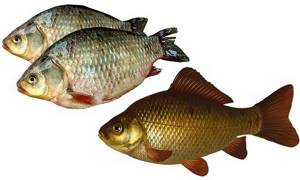
Goldfish and silverfish spawn at different water temperatures
In early spring, you should look for crucian carp in shallow water. Here the fish, after hibernation, begin to actively feed. After all, water in areas with a depth of about half a meter warms up noticeably faster. Here the crucian carp like to “stand” under the warm rays of the sun, and there is more food supply in the form of larvae and first algae.
Habitats of crucian carp
Crucian carp is an extremely unpretentious aquatic inhabitant, which can be found both in reservoirs of Central and Eastern Europe, and in Siberia. These can be either flowing lakes and deep rivers, or shallow, swampy ponds. Thanks to its endurance, crucian carp easily tolerates both a sharp decrease in the level of oxygen in the water (to levels that no other type of fish can withstand) and extremely low temperatures, which is why it simply freezes into the ice, but survives until the onset of a thaw.
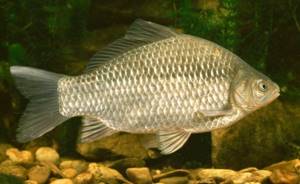
Despite its unpretentiousness to environmental conditions, the favorite habitat of this aquatic inhabitant is medium-deep, swampy reservoirs with stagnant, moderately warm water.
It stays close to the bottom (depth about 2 m), which has a muddy surface overgrown with algae. In such conditions, it is able not only to find food for itself, but also to hide from predators. With the onset of spring, as the water warms up, crucian carp begins to stay closer to the shore, and on hot summer days it usually hides in holes.
Did you know? Crucian carp is famous for its unusual preferences in the field of various aromas. Thus, many experienced fishermen add anise, garlic, onion, valerian drops and even kerosene to the bait.
Air temperature
When it comes to air temperature and its effect on how lake fish bite, it is important to take into account the time of year. If it’s spring, the warmer it is outside, the brighter the sun shines, the better it is for catching crucian carp. The fact is that the fish are just waking up from hibernation and the slightest warming only increases its activity and hunger.
In summer the situation changes a little. High air temperatures and hot weather negatively affect the bite. The fish are forced to retreat to deep holes, where there is more oxygen, and wait for a slight cooling. Therefore, in June-July, it is best to go crucian carp fishing in the early morning (from 4 to 10) or at the so-called evening dawn (from 18 to 22), when the sun does not shine so brightly.
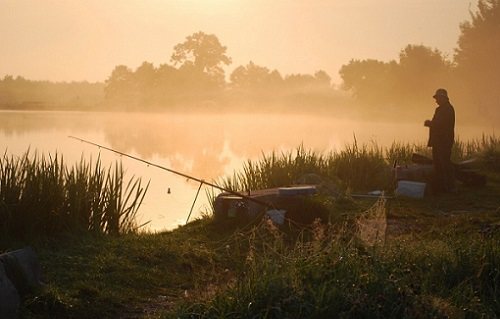
In the summer, the catch of crucian carp will be better in the morning, when the air temperature remains low
Crucian carp also do not like it when it gets very cold in the summer. In this case, the fish bite extremely rarely and mainly only on animal bait. In the autumn months, it is optimal for fishing when the air temperature has not changed by more than 5°C for 2-3 days. Moreover, if the weather is sunny, the fish bite much better and more often. At the end of September and October, during the first frosts, crucian carp may even begin to burrow into the silt - naturally, it is difficult to catch them, and there is no point in counting on a good catch.
Where to look for crucian carp
In winter, crucian carp is found in various natural and artificial reservoirs, where there are favorable conditions for it. This fish remains active in winter if it does not experience oxygen starvation. If there is spring recharge near a river, lake, pond or quarry, then the crucian carp will regularly swim to their feeding places.

In winter, it spends most of its time at depth, and in good weather, it swims to medium depths, to places where there is a lot of remnants of vegetation, to feed. If there are no pikes and perches in the reservoirs, and they are well supplied with oxygen in winter, then in these places, if the weather is good in winter, crucian carp will always bite.
For successful fishing, it is better to choose places with a sandy or clay bottom. In reservoirs with silt deposits, fishing becomes difficult in winter.
Mature crucian carp usually feed on vegetation, zooplankton and zoobenthos, while young ones prefer plankton. Choosing reservoirs with a favorable food supply for crucian carp will ensure a good bite throughout the winter.
Wind
Particular attention must be paid to strength and direction. In stormy and gusty winds (from 20 m/s), the fish, as a rule, bite very poorly. It’s also difficult to react to a bite – be it float or bottom tackle. Strong wind causes the bait to move unnaturally and intensely on the bottom, which frightens the wary crucian carp.
Complete calm, as a rule, is also unfavorable for fishing. There is less oxygen in the water, the heat increases, and even small crucian carp are sent to the depths, where they can be periodically caught only with the help of a feeder and long casting. A warm southern wind with small gusts of up to 7-10 m/s has a positive effect on crucian carp’s interest in bait. When eastern and northern winds blow, there is a sharp decrease in the bite, especially in summer.
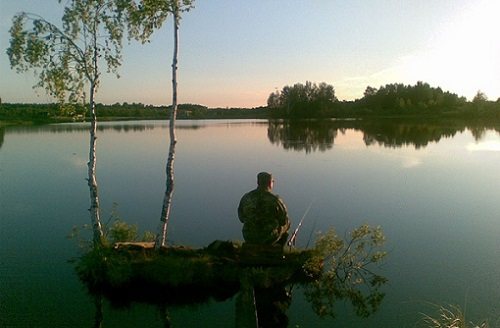
Both in strong wind and in its absence, crucian carp will practically not be caught
Experienced fishermen also recommend positioning themselves on the reservoir on the leeward shore. Thus, the current created by the wind redistributes the food supply, carries in the direction where the bait equipment is located, the remains of complementary food, various larvae, etc., which greatly attracts fish. True, if the wind is too strong, then the waves beating against the shore and coastal vegetation create noise that alarms the crucian carp.
If, looking outside, you notice a real squall, then it is better to stay at home. But after the wind subsides, you can safely go catch this fish - crucian carp are very fond of feeding near the shore, where there is a lot of delicacy for them, washed by the wave from all over the reservoir.
Another fact related to the influence of weak wind on the success of fishing is the creation of ripples, which better saturate the water with oxygen and serve as a kind of “camouflage”, because. the fish does not see what is happening on the shore and is more confidently interested in the baited hook.
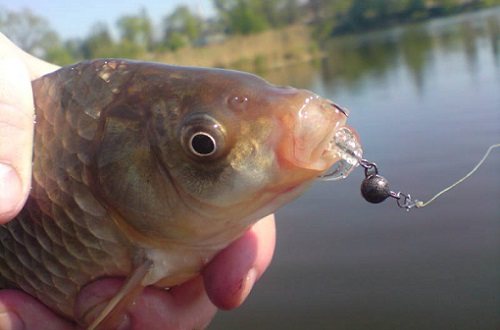
Light winds are optimal for successful crucian carp fishing.
Do not forget about the location of the reservoir, which may be in a hollow or surrounded by forest on all sides. In this case, the wind has little effect on the bite. The behavior of the fish depends more on the temperature of the water and air, pressure, current, and even on the bottom topography in the place where the fishing is taking place.
Bite forecast
Most fishing enthusiasts go to the pond with a fishing rod only when they have free time. For example, on the long-awaited only day off or even for a couple of hours after work. In such cases, it is difficult to take into account weather conditions, including atmospheric pressure, possible cyclones, wind direction, etc.
However, if you are focusing specifically on the results of fishing and the number of fish caught, and not just on a pleasant pastime on the shore of the lake, then you need to make a bite forecast in advance. This is done quite simply. Let's say you go fishing tomorrow or the day after tomorrow. So, when looking at the weather forecast, pay special attention to:
- air temperature;
- wind strength and direction;
- precipitation;
- atmospheric pressure.

When going fishing for crucian carp, you should take into account the weather on that day, because... otherwise there may be no bite
Of course, experienced fishermen will say that these 4 points are not enough. It is important to know the water temperature, the geomagnetic situation, and even the phase of the moon. But still, weather factors are much more significant, so we will consider each of them and determine their positive and negative impact on the outcome of successful fishing.
Atmospheric pressure fluctuation
The normal life of fish in a reservoir implies that the water pressure parameters in the fish bladder and in the air must be equal. If the general atmospheric air pressure is increased, this leads to a double load on the body of the goldfish. Naturally, the fish don’t like this. On such days, many fish try to float to the surface of the water and relieve excess pressure from the air bubble, or, conversely, swallow air. In this way, they achieve balance. Crucians do not like such procedures.
Normal air pressure is approximately 750 mmHg. The best bite for crucian carp is observed precisely at these values. If an increase in level is observed, the fish rises to reduce the hydraulic pressure in its body. On such beautiful, sunny days, a flock of crucian carp lazily mixes near the surface layer of water, completely not reacting to the bait.
Read: Fishing for crucian carp in autumn
When the atmospheric background is low, the fish goes to depth to increase the load of the water column. If fishing takes place in warm weather, and even with reduced pressure, it would be a good idea to bite near deep holes. When it gets colder, crucian carp burrow into the mud and will not respond to bait.
When there is variable pressure, the fish will be better off biting when the background is low rather than when it is high, as it gradually goes back to its usual places.

